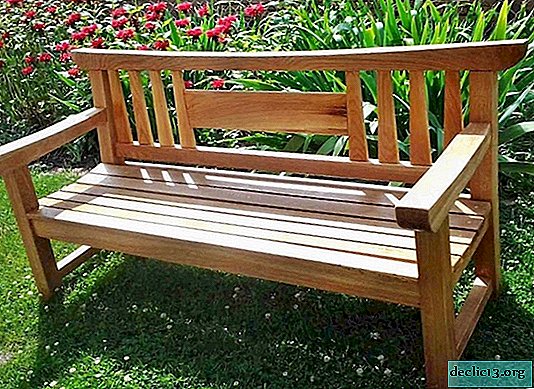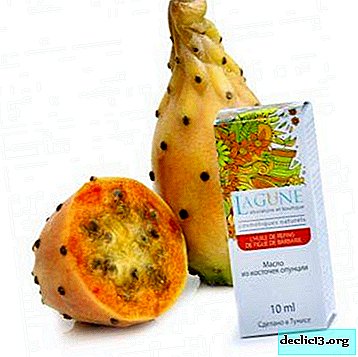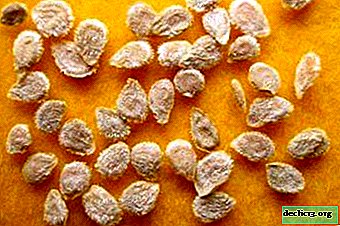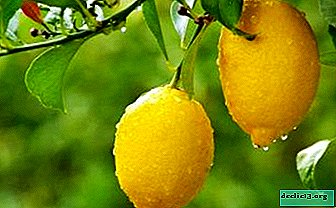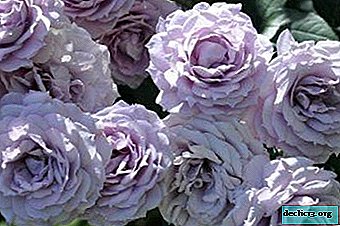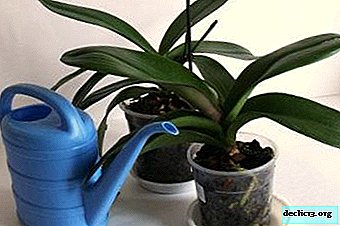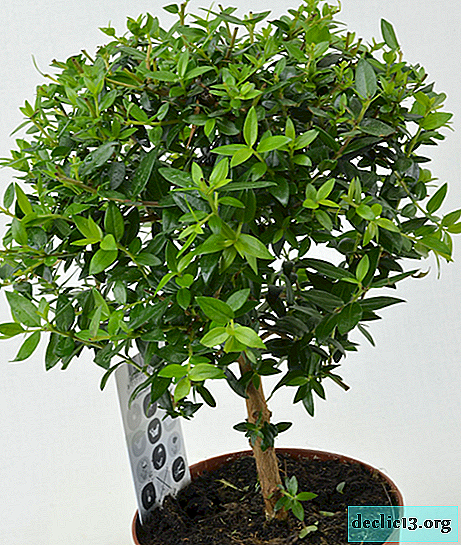Retire gloxinia at rest - when is it necessary?
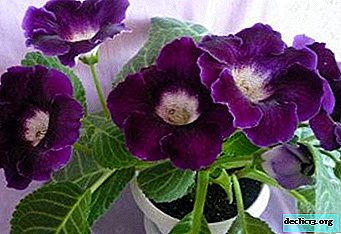
The heart beats with delight when you admire the blooming gloxinia, so diverse in color, shape and size, with luxurious velvet-double petals, similar to miniature gramophones.
The leaves of the plant are also with a velvety surface, juicy petioles, expressive green color.
Gloxinia is also a source of an unusual soft aroma, which, incidentally, does not come from flowers, but from foliage.
Features
The plant is thermophilic and grows well with an air humidity of at least 50%. This is a tuberous type belonging to the Gesneriaceae. The second name is Sinningia. It came to us from the tropics. Gloxinia lived in the mountainous areas of the Amazon River, in its upper part. There, periods of heavy rains turn into winter drought with lowering temperatures and the flower is used to hiding and waiting until the rain-feeding rains come again. Therefore, gloxinia refers to flowers that require a dormant period.
Interestingly, in the past amateur gardeners often believed that dropping leaves and wilting, gloxinia passed away and was simply thrown away. It is necessary to care for it in resonance with its biorhythms, otherwise the plant will be exhausted, waste its life potential irregularly, will not have time to gain enough strength for the forthcoming flowering and may even die.
At home, she grows well in the kitchen and on the insulated loggia.because there the humidity is higher. The plant is propagated by cuttings, leafy and from the tops, as well as seeds and tubers (on how to grow gloxinia from a leaf, read here).
On a note. Gloxinia itself “knows” when it needs to rest, at which time the foliage begins to turn yellow.Usually a plant is prepared for bed from September to October. Gradually, watering is reduced to nothing, and dried leaves are carefully cut, the pots are moved to shaded places. The dream of a flower is quite long, it takes more than one month.
How and when does this happen?
Wintering of adult plants
 In autumn, the flowering of adult synningia is no longer so active and gradually stops altogether. In order not to bring down the natural process, gloxinia cease to feed, minimize watering. Enough time should pass before gloxinia can be hibernated. Cut drying leaves can be at the very root, or you can, leaving arrows 2-3 cm. Ideal for the winter is a dark zone with temperatures from + 10 ° C to + 13 ° C.
In autumn, the flowering of adult synningia is no longer so active and gradually stops altogether. In order not to bring down the natural process, gloxinia cease to feed, minimize watering. Enough time should pass before gloxinia can be hibernated. Cut drying leaves can be at the very root, or you can, leaving arrows 2-3 cm. Ideal for the winter is a dark zone with temperatures from + 10 ° C to + 13 ° C.
During sleep gloxinia is very poorly watered, once or twice a month. Pour some water strictly along the edge of the pots so as not to wet the surface of the tuber. When watering take a little warm water.
The second variant of hibernation is the storage of tubers in a sandy type substrateeither in peat or in sphagnum moss. The tubers are removed from the pot and dripped into the selected substrate, keeping there until the end of the winter period. Each month, a coma in which the tuber is stored is sprayed with warm water once.
The temperature is needed the same as in the first version, 10-13 degrees. More experienced flower growers-masters, knowing the nature and habits of the plant, having studied them subtly, are guided by other indicators using a labile schedule of dormancy, where in each case the period is calculated individually.
Young plants
Gloxinia in the first year of life, has not yet entered the flowering period and has not grown a tuber about a couple of centimeters, spends the winter without sleep. But it is necessary to take into account the features of the normal conditions of her life for this specific period. For twelve to fourteen hours every day, the plant must be provided with adequate lighting. The temperature in the room where gloxinia is located is required somewhere + 18-19 degrees. Such winter conditions will ensure gloxinia healthy development, it will not stretch and will put all its strength into the development and increase of the tuber.
- If young gloxinia has already tried to bloom and grow a small tuber, then wintering occurs in a different way. Since autumn, active watering is switched to moderate mode and the pot is removed in a less lit place. The plant during the winter is half asleep (how to properly water and feed gloxinia at home can be found here).
Reference. When the day becomes longer, more sunlight appears, then the rested babies are returned to their original place.
Usually they choose the brightest position, in time this stage falls on the beginning of February.
- Young gloxinia, grown from seeds at first for winter sleep, are not sent until they load the desired size of the tuber.
Average universal parameters
- A place without bright light.
- The temperature regime is from +3 to +15 degrees.
- Humidity is not more than 90% and not less than 60%.
As a result
We model weather factors that are common to plants in their natural habitat.
Estimated Tuber Storage Locations
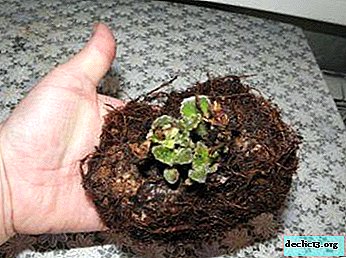 Fridge, the department with the lowest temperature, where vegetables and greens are usually stored. There is a danger of over-drying the tubers, so you need to regularly check the sosbtrat for moisture.
Fridge, the department with the lowest temperature, where vegetables and greens are usually stored. There is a danger of over-drying the tubers, so you need to regularly check the sosbtrat for moisture.- Insulated balcony or loggiawhere the temperature does not rise more than twenty degrees, as the plant may wake up from heat.
- Cellar, deep and warm, where the temperature drop does not go beyond + 3-5 degrees. Storage in the cellar is only possible with moderate humidity, when the walls and shelves are not affected by mold. Here you can safely leave the tubers and not worry that they can dry out.
- Under the bath. Humidity and light parameters are ideal, but the temperature may not match, be higher than expected.
- On the mezzanine in the hallway. The main thing here is not to forget about hydration.
How it's done?
- We remove the tuber, free it from the ground, store it like that.
- We extract the tuber along with a small amount of soil, and he spends the winter in this form.
A detailed description of the process of preparing for hibernation
Flowering is completed, usually this time is from August to October. We begin to reduce watering. Gloxinia can stubborn and not go to sleep, continuing to bloom even in November, then you need to wait until flowering is over and start preparing the plant for sleep later.
Reducing watering, we force the leaves to dry, turn on the weather bell for the plant, which commands gloxinia to fall asleep, as in its homeland, when the rainy season is replaced by a drought. Naturally, the plant is not fed with fertilizers. However, a single feeding with a potassium supplement will be appropriate, for example, you can take potassium monophosphate. Completely stop watering after the last leaf dries.
Attention! It is very important not to immediately remove the ground part of the plant, it takes some time for all the nutrients to be localized in the tuber, throwing leaves and stems.This factor will largely create successful wintering conditions and help gloxinia develop well and bloom in the upcoming season of activity. The minimum stalk residue from wilted leaves is one centimeter, the maximum is three centimeters.
By the time of readiness for sleep, gloxinia dies as the upper ground part, and the fiber of the roots, only the tuber remains. It is there that the whole life potential of the plant is concentrated and stored.
We talked more about how long gloxinia blooms and how to prepare a wintering flower in our material.
How to get it?
The method that will be optimally applied depends on which storage option is selected - in or without soil.
Without soil
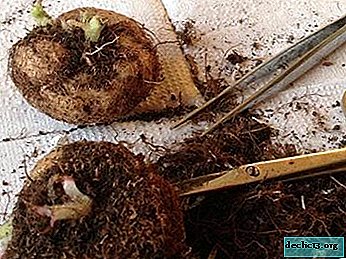 Remove the tuber, preferably using the transshipment method.
Remove the tuber, preferably using the transshipment method.- Take a bowl for the soil, for example, a basin
- Gently turn the pot over the container, not completely upright, but at an angle.
- Roll out the tuber along with the soil.
- Carefully knead the earth volume with your hands until it releases the tuber.
- Peel the tuber of soil and roots
- Rinse the tuber under lukewarm water.
- Drain it a little to prevent rot during storage.
- As a substrate for storage, you can take sand or sawdust. Sand is suitable only for river type. It needs to be calcined.
- The substrate should be moderately moist.
- Put all this in a plastic bag (with a zip and a label with the packing date) as follows: pour sand, put a tuber, again pour a layer of sand. We also act with sawdust. The tuber should take cover completely.
A sore spot eaten by a fungus, after cleansing, sprinkle with ash. If the tuber was acquired in the fall, then during storage it is necessary to use the groundless method, disinfection both before hibernation and after it (for more information about gloxinia diseases and methods of their treatment click here).
In the soil
This is a simpler and more reliable option, the risk of decay is minimal. Preparing for sleep is carried out according to the same scenario. You can find out how to choose the best primer for gloxinia here.
- We move the pot with the tuber to a cool and shady place.
- Periodically slightly moisten the top of the soil.
- You can add ice cubes to lower the temperature.
You can also cover the pot with a bag and keep it cool. Do not forget to check for moisture and make sure that the tuber does not sprout. To "control" the temperature, you can put the pot in a box and put a thermometer in it. The same applies to the groundless storage method. Checking tubers should be done twice a month.
Awakening
 The rest period lasts four to five months. By the end of January, you can wait for awakening in the form of the first sprouts. When this happens, you should return the plant to the pot with fresh soil and put it in the brightest place (we wrote here about the size of the pot for the healthy development of gloxinia). Buried quite a bit. The sprout should rise slightly above the layer of earth, or be on a par with it. In the first seven days, watering is not done, then they begin with moderate doses of moisture, gradually bringing to normal.
The rest period lasts four to five months. By the end of January, you can wait for awakening in the form of the first sprouts. When this happens, you should return the plant to the pot with fresh soil and put it in the brightest place (we wrote here about the size of the pot for the healthy development of gloxinia). Buried quite a bit. The sprout should rise slightly above the layer of earth, or be on a par with it. In the first seven days, watering is not done, then they begin with moderate doses of moisture, gradually bringing to normal.
They do not stimulate growth until February, so that the tuber does not spend strength, because the more it will be, the more blooming will become. Excess shoots are removed, leaving three or four little things when they reach a five-centimeter length.
You can use them for breeding, rooting in a jar, like a small greenhouse, periodically hardening and ventilating.
Attention! If it turned out that the tuber at the end of hibernation struck rot, then you need to disinfect it with the above method.You can also put in root for recharge.
Useful video
The rest period in gloxinia. Winter storage of gloxinia tubers at rest:
Conclusion
Advantages and disadvantages of soil and soilless methods:
- minimal risk of drying during soil storage, especially important for young plants;
- storage in pots takes up a lot of space;
- when groundless storage in bags can control for rot;
- the ungrounded method makes wintering in the refrigerator possible.

 Fridge, the department with the lowest temperature, where vegetables and greens are usually stored. There is a danger of over-drying the tubers, so you need to regularly check the sosbtrat for moisture.
Fridge, the department with the lowest temperature, where vegetables and greens are usually stored. There is a danger of over-drying the tubers, so you need to regularly check the sosbtrat for moisture. Remove the tuber, preferably using the transshipment method.
Remove the tuber, preferably using the transshipment method.




